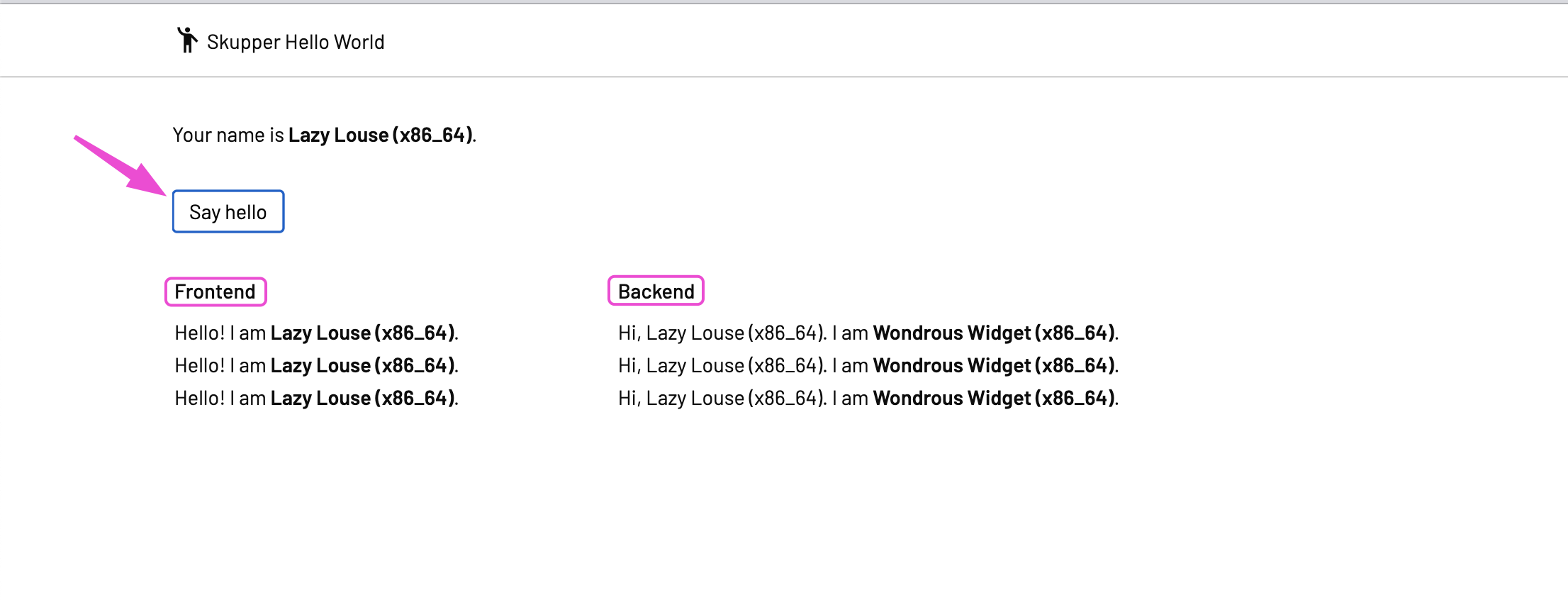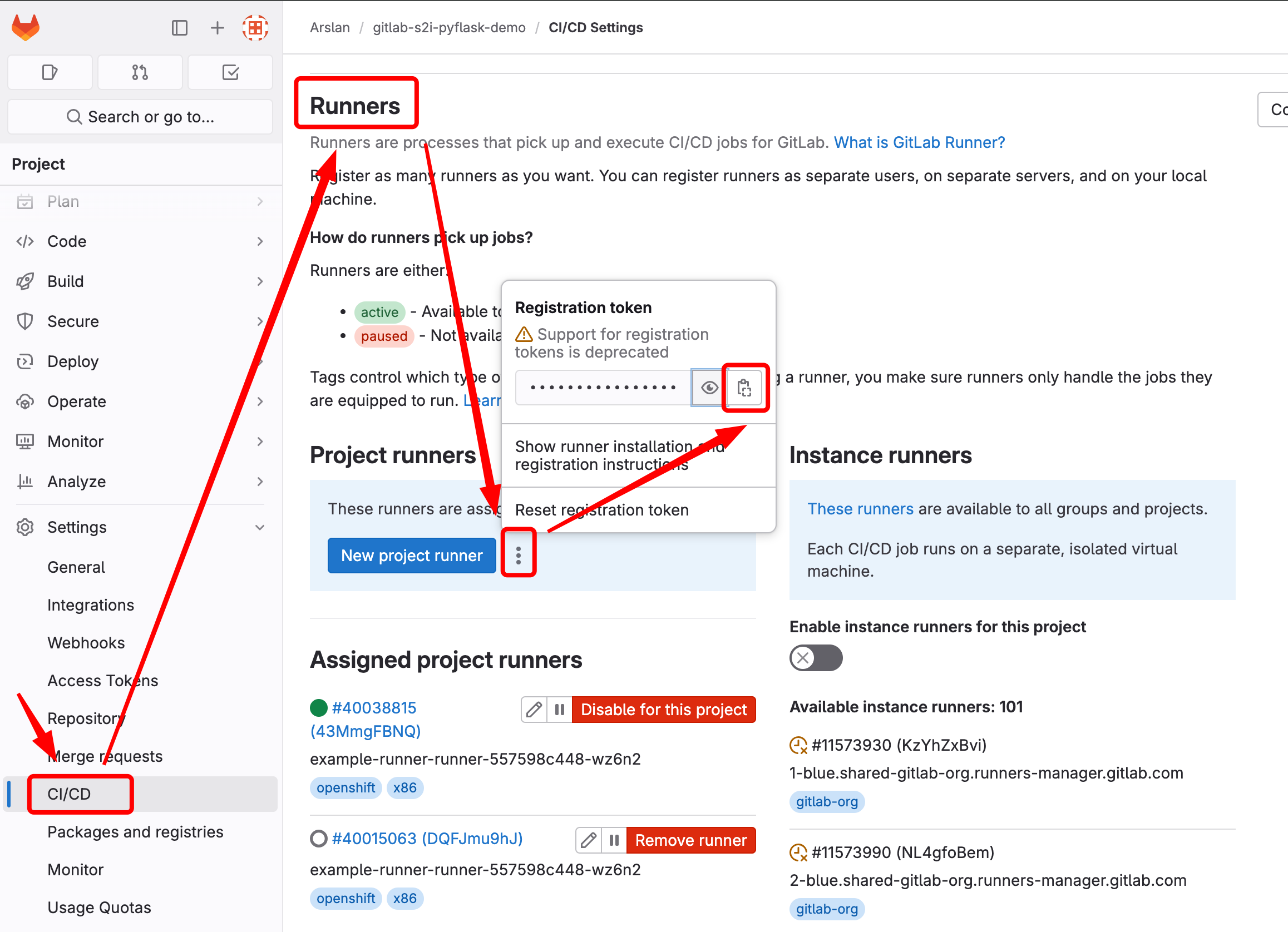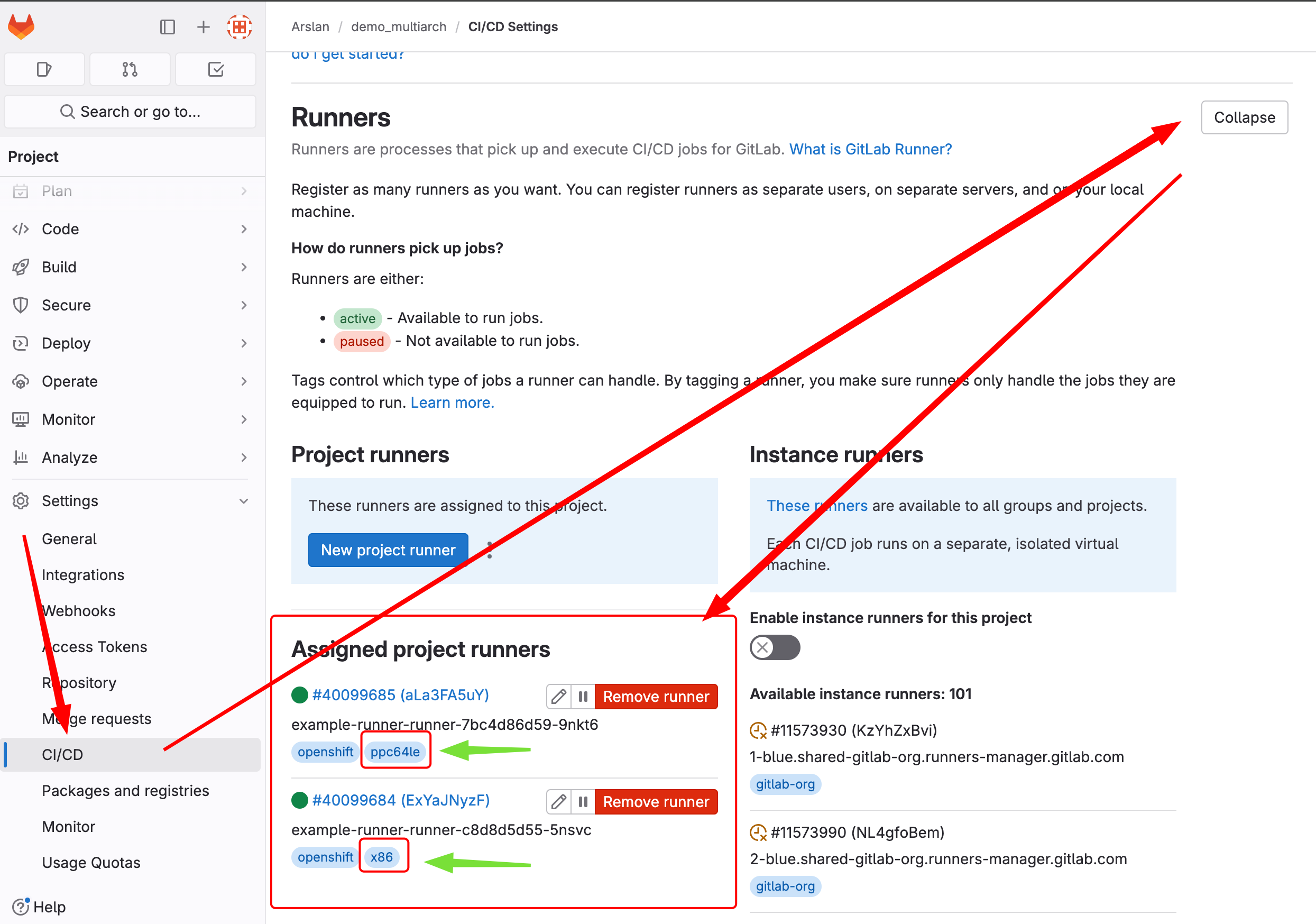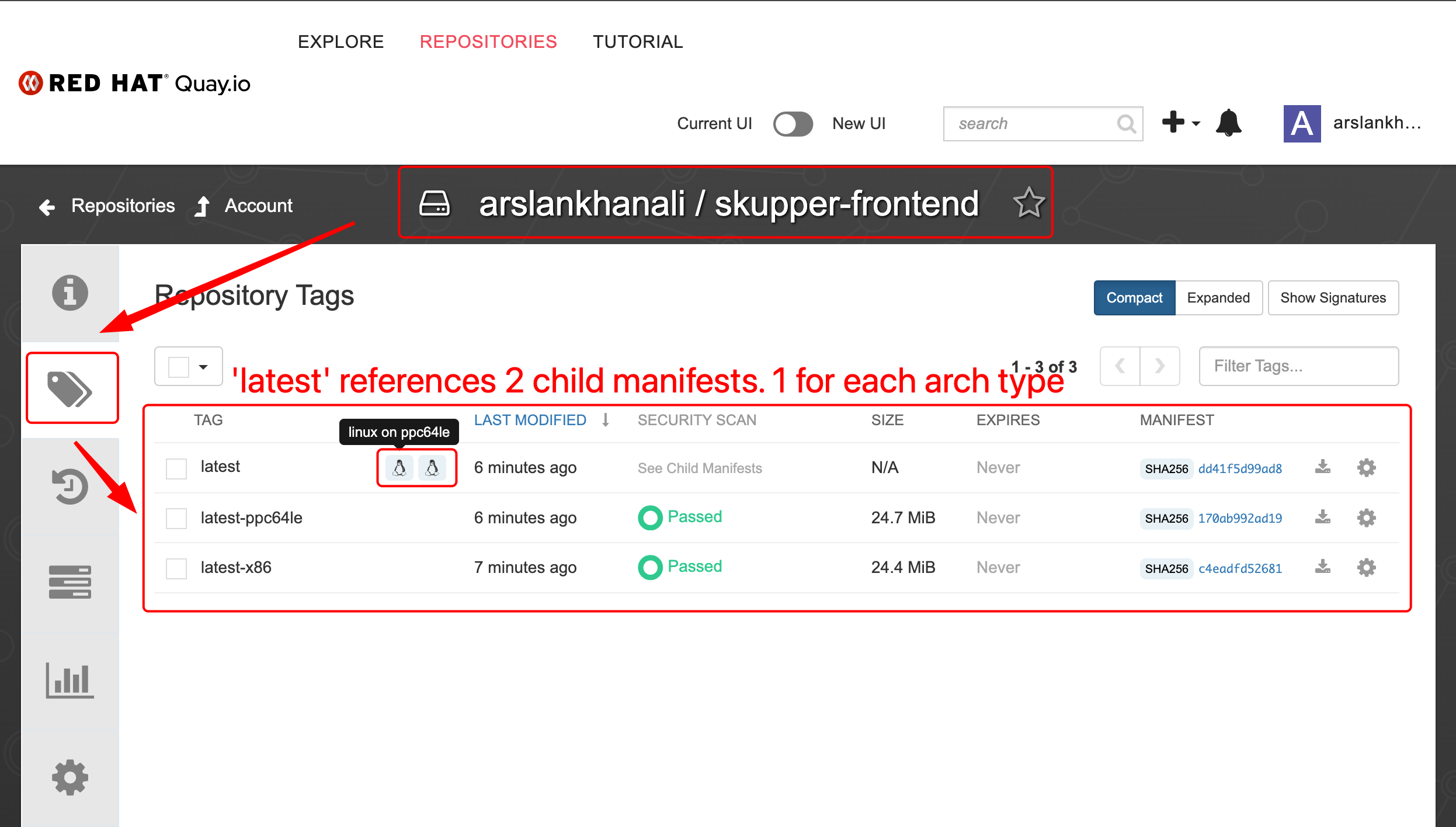The CI pipeline gets triggered whenever a change is made to the pipeline itself and/or application code. This pipeline trigger will cause the OpenShift cluster to build the HW architecture-specific container image(s)—x86 image and ppc64le image in our case—and push them to the container registry (Quay.io in this case). Eventually, the pipeline will combine the different (HW-specific) container images and create a multi-architecture (single) image which can be used across x86 and ppc64le OpenShift clusters. This saves the developers and operations team from dealing with multiple container images for an application.
Using Gitlab-CI pipeline across multiple OpenShift clusters with different CPU architectures.
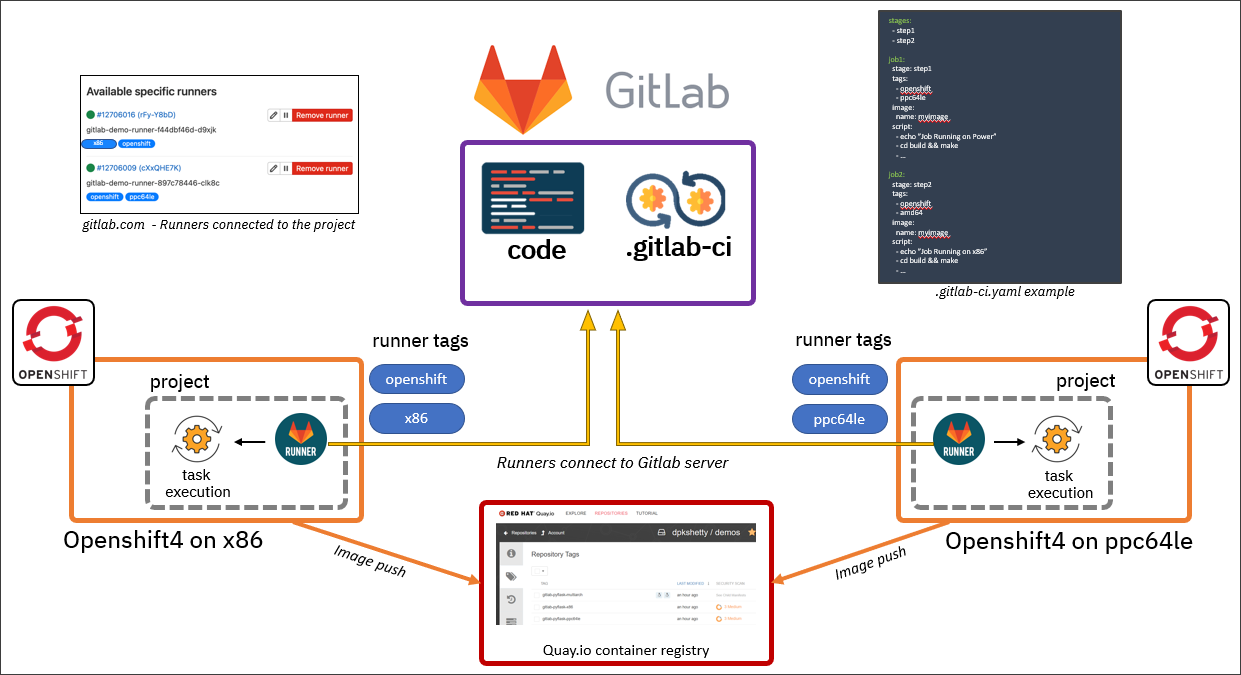
Before we start, here are some fyi only
- Continuous Integration: This Readme will focus on GITLAB-RUNNERS for CI. But there is also working code for TEKTON-PIPELINES and GITHUB-ACTIONS in this repository. GITHUB-ACTIONS workflow builds image for 6 (arm, arm64, 386, amd64, ppc64le, s390x) different CPU architectures each time the code is pushed to github.

- All the resultant images are in 2 repositories quay.io/arslankhanali/skupper-frontend & quay.io/arslankhanali/skupper-backend.
- argo: folder has the code to deploy application with GitOps
- Manifests: You can also use manifests to deploy application
- Access to OCP cluster on x86 and PPC
- Quay.io account with 2 repositories
- gitlab repo
- We will be using modified hello-world application from skupper.io.
- CI Pipeline
- Setup GitLab Runner on clusters
- Provide Gitlab with Quay variables.
- Deploy Application
- Deploy frotend on cluster1
- Deploy backend on cluster2
- Connect both namespaces with skupper
- Verify that app is running
- CONGRATULATIONS - You have done it
# canberra: TERMINAL TAB
export KUBECONFIG=$HOME/.kube/config-canberra
oc login --server=https://api.cluster-pmvqm.sandbox432.opentlc.com:6443
oc get -o jsonpath='{.status.infrastructureName}' infrastructure cluster
# sydney: TERMINAL TAB
export KUBECONFIG=$HOME/.kube/config-sydney
oc login --server=https://api.cluster-s5cqt.dynamic.redhatworkshops.io:6443
oc get -o jsonpath='{.status.infrastructureName}' infrastructure clusterUse export KUBECONFIG=$HOME/.kube/config-sydney in any new terminal tab to make sure it connects to this particular cluster.
Most of these steps will be similar on any OpenShift clusters. Except create Runner part where you will have to provide the correct tag.
# Run v1.26.2
# Run v1.27 had some issues
All Namespaces
cat << EOF | oc apply -f-
apiVersion: operators.coreos.com/v1alpha1
kind: Subscription
metadata:
name: gitlab-runner-operator
namespace: openshift-operators
spec:
channel: stable
installPlanApproval: Automatic
name: gitlab-runner-operator
source: certified-operators
sourceNamespace: openshift-marketplace
EOFGitlab Runner pods will run in this project.
These pods will help in building images.
# oc new-project gitlab
cat << EOF | oc apply -f-
apiVersion: v1
kind: Namespace
metadata:
name: gitlab
EOFTo convert token to base64 and edit below
echo -n <GL127690123602193703217> | base64cat << EOF | oc apply -f-
kind: Secret
apiVersion: v1
metadata:
name: gitlab-runner-secret
namespace: gitlab
data:
runner-registration-token: R1IxMzQ4OTQxY1hwNHUI0ek5QbW0=
type: Opaque
EOFcat << EOF | oc apply -f-
apiVersion: v1
kind: ServiceAccount
metadata:
name: gitlab-runner-sa
namespace: gitlab
EOFUse the correct tag as per your arch and then reference it in .gitlab-ci.yml file.
Examples:
tags: openshift, x86 (as used in our case below)
or
tags: openshift, s390x
or
tags: openshift, ppc64le
or
tags: openshift, arm
x86
# For x86 OCP Cluster
cat << EOF | oc apply -f-
apiVersion: apps.gitlab.com/v1beta2
kind: Runner
metadata:
name: example-runner
namespace: gitlab
spec:
concurrent: 10
gitlabUrl: https://gitlab.com
serviceaccount: gitlab-runner-sa
tags: openshift, x86
token: gitlab-runner-secret
EOFppc64le
# For PPC OCP Cluster
cat << EOF | oc apply -f-
apiVersion: apps.gitlab.com/v1beta2
kind: Runner
metadata:
name: example-runner
namespace: gitlab
spec:
concurrent: 10
gitlabUrl: https://gitlab.com
serviceaccount: gitlab-runner-sa
tags: openshift, ppc64le
token: gitlab-runner-secret
EOFcat << EOF | oc apply -f-
kind: RoleBinding
apiVersion: rbac.authorization.k8s.io/v1
metadata:
name: add-anyuid-to-my-gitlab-sa
namespace: gitlab
subjects:
- kind: ServiceAccount
name: gitlab-runner-sa
namespace: gitlab
roleRef:
apiGroup: rbac.authorization.k8s.io
kind: ClusterRole
name: 'system:openshift:scc:anyuid'
EOF
cat << EOF | oc apply -f-
kind: RoleBinding
apiVersion: rbac.authorization.k8s.io/v1
metadata:
name: add-my-gitlab-sa-to-runner-app-role
namespace: gitlab
subjects:
- kind: ServiceAccount
name: gitlab-runner-sa
namespace: gitlab
roleRef:
apiGroup: rbac.authorization.k8s.io
kind: Role
name: gitlab-runner-app-role
EOFThis is needed so gitlab pipeline can push images to Quay.
Create 2 PUBLIC repositories.
- skupper-frontend
- skupper-backend
- Give robotaccount access to the BOTH repositories. Access to skupper-frontend is shown below. Do the same for skupper-backend
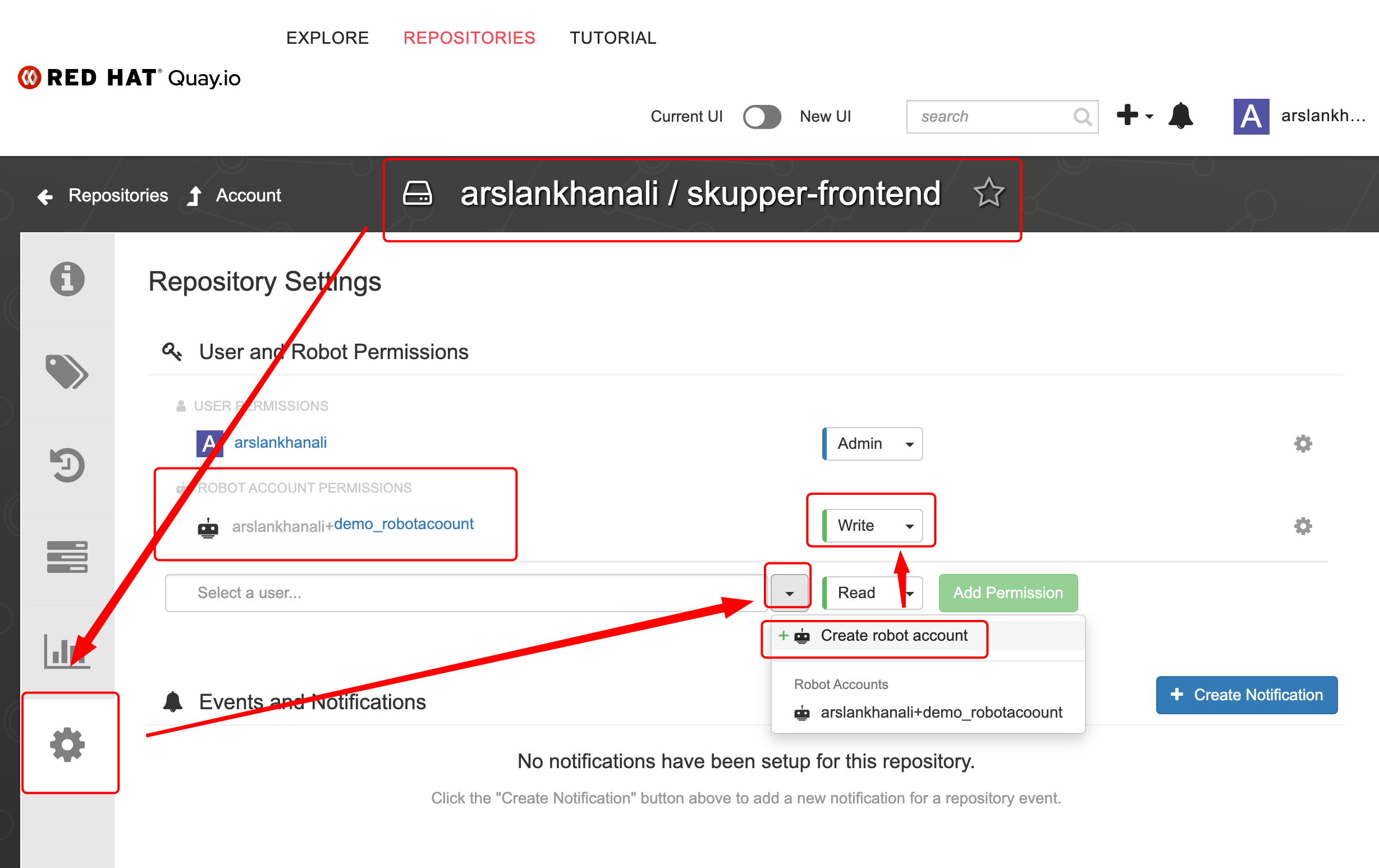
Create 2 variables
- quay_user
- quay_passwd
.gitlab-ci.yml will reference these when pushing images to quay.
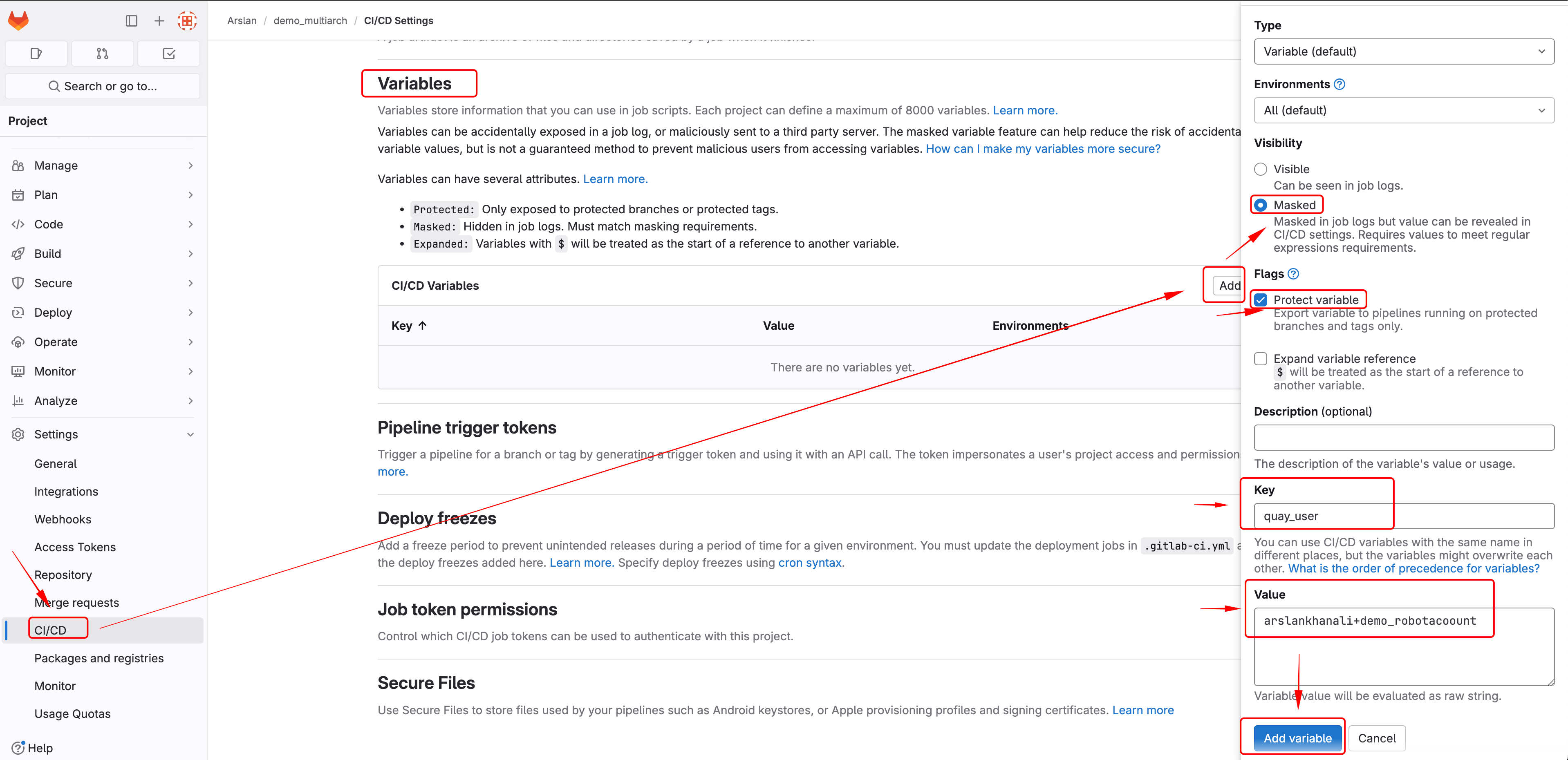
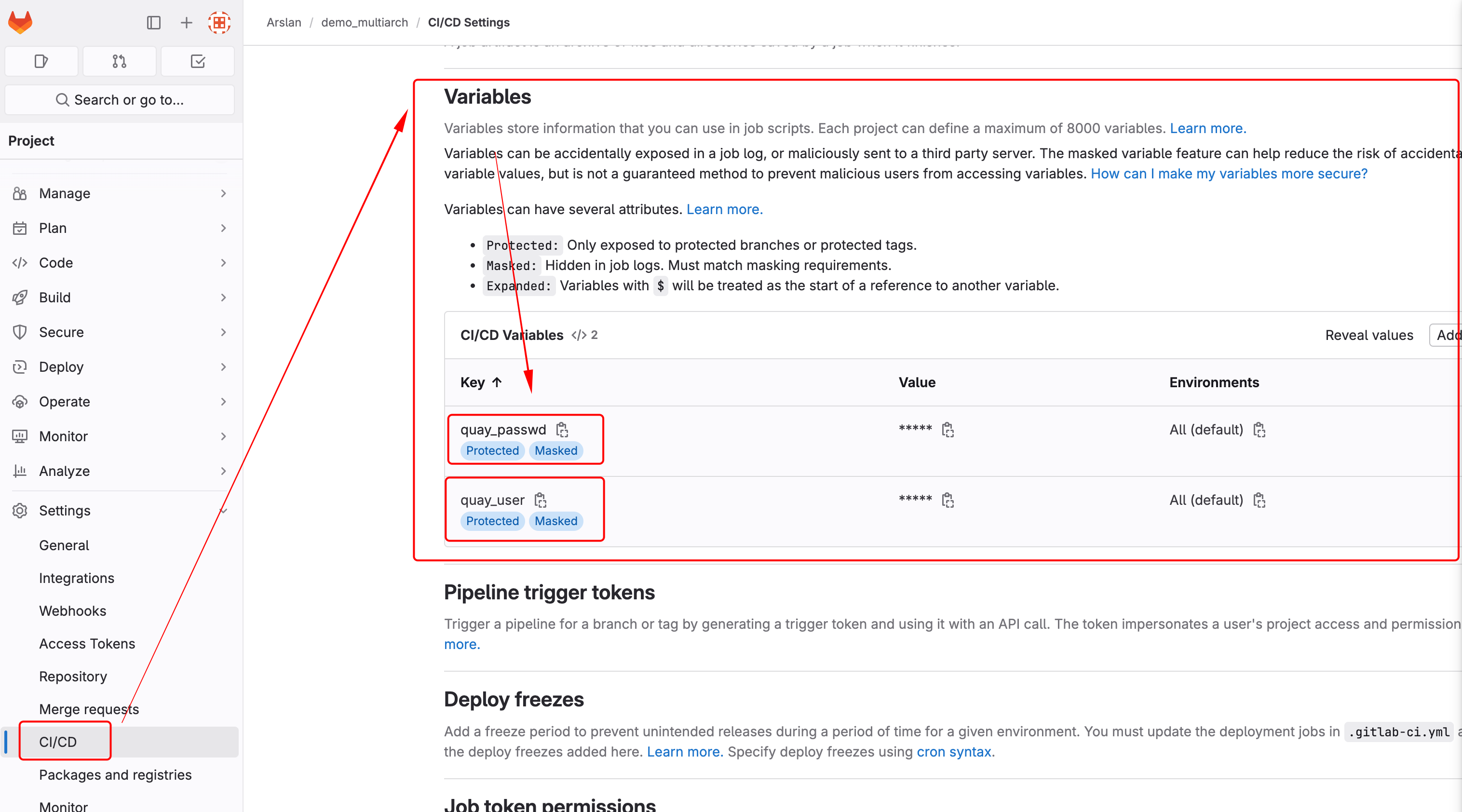
APIs can be used to create these variables as well.
Push changes to git repo and CI pipeline will start Automatically.
New pods with the name of 'runner*' will pop up in gitlab project in both OCP clusters.
Check the status of CI pipeline.
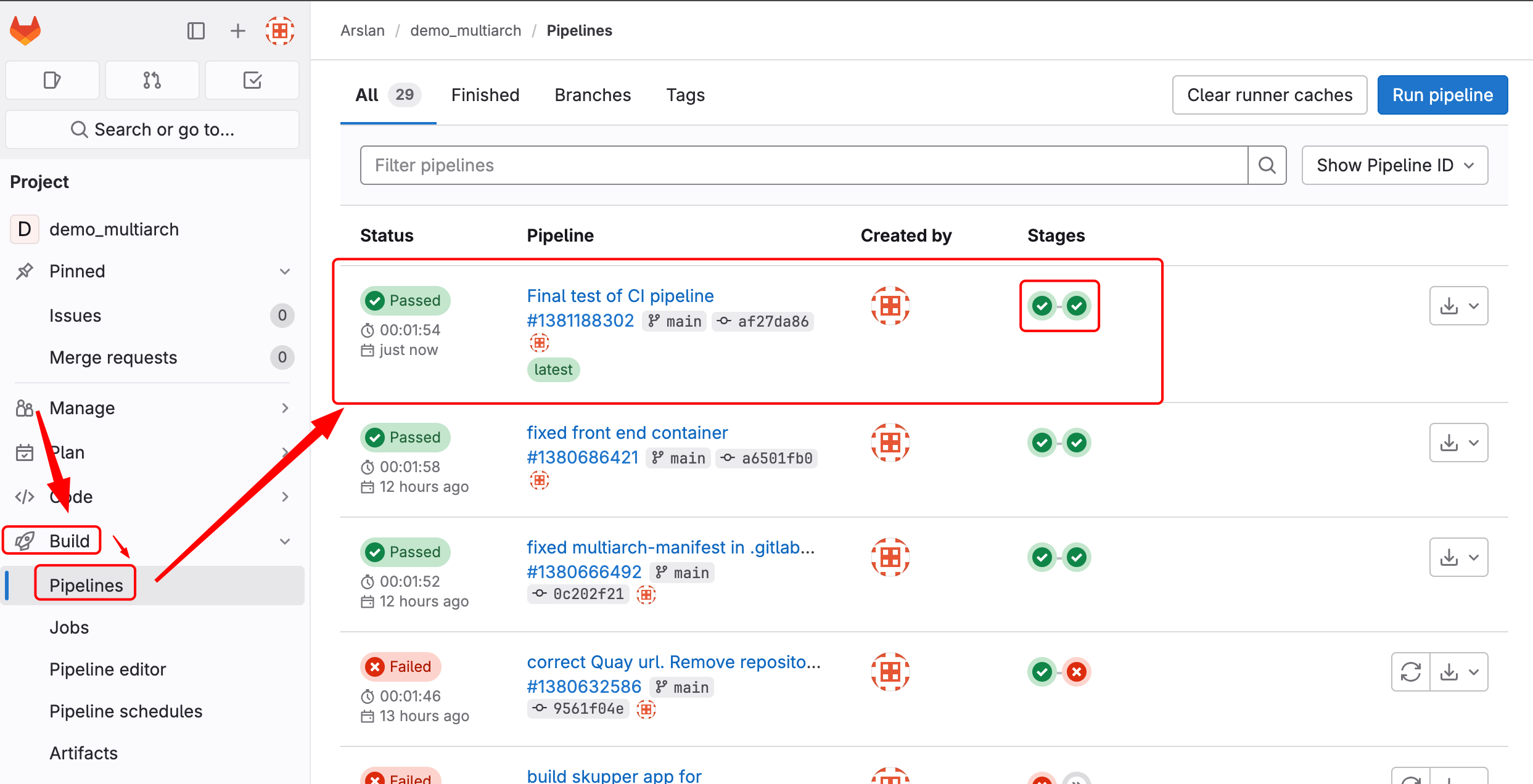 You can see the logs by clicking on each Job
You can see the logs by clicking on each Job
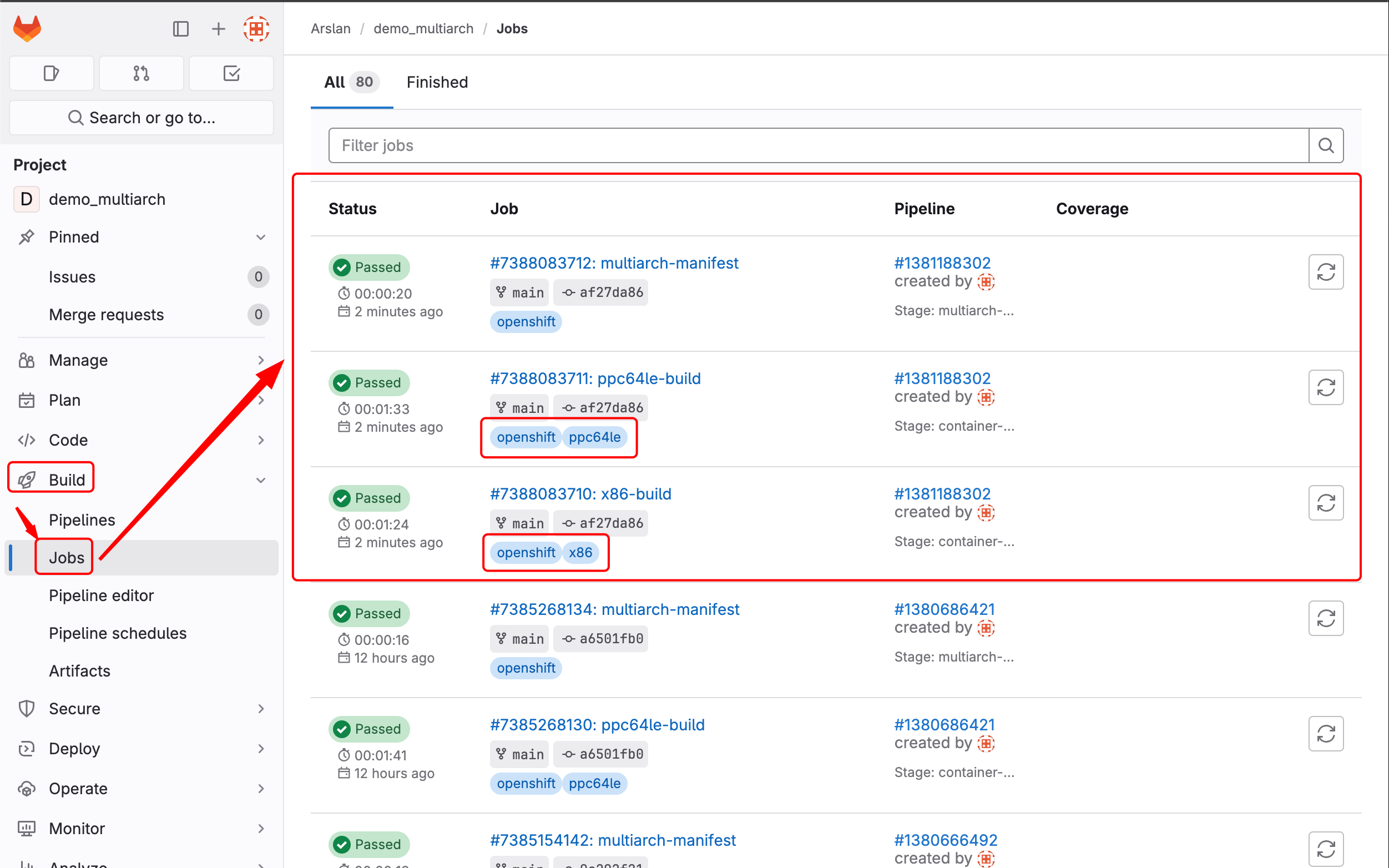
# ----------------
# NAMESPACE CANBERRA
# ----------------
# Deploy frontend in namespace canberra
oc new-project canberra
oc new-app --name=frontend -l app=hello quay.io/arslankhanali/skupper-frontend:latest
oc create route edge frontend --service=frontend --port=8080
echo "https://$(oc get route frontend -o jsonpath='{.spec.host}')"
skupper init --enable-console --enable-flow-collector
skupper token create ~/canberra-sydney.token
skupper token create ~/canberra-melbourne.token
echo "https://$(oc get route skupper -o jsonpath='{.spec.host}')"
oc get secret skupper-console-users -n canberra -o jsonpath='{.data.admin}' | base64 --decode # user is admin
# Stress test. https://<url-from-above>/api/hello
ab -n 100 -c 10 -p skupper-app/payload.json -T application/json "https://$(oc get route frontend -o jsonpath='{.spec.host}')"/api/hello
# ----------------
# NAMESPACE SYDNEY
# ----------------
# Open new terminal tab - make sure its still cluster1
# Deploy backend in namespace sydney
oc new-project sydney
oc new-app --name=backend -l app=hello quay.io/arslankhanali/skupper-backend:latest
skupper init --ingress none
skupper link create ~/canberra-sydney.token
skupper expose deployment/backend --port 8080
# ----------------
# NAMESPACE MELBOURNE
# ----------------
# Deploy backend in namespace melbourne
oc new-project melbourne
oc new-app --name=backend -l app=hello quay.io/arslankhanali/skupper-backend:latest
skupper init --ingress none
skupper link create ~/canberra-melbourne.token
skupper expose deployment/backend --port 8080
# ----------------
# NAMESPACE east
# ----------------
# Deploy frontend in namespace east
oc new-project east
oc new-app --name=frontend -l app=hello quay.io/arslankhanali/skupper-frontend:latest
oc create route edge frontend --service=frontend --port=8080
echo "https://$(oc get route frontend -o jsonpath='{.spec.host}')"
skupper init --enable-console --enable-flow-collector
skupper token create ~/east-west.token
oc get secret skupper-console-users -n east -o jsonpath='{.data.admin}' | base64 --decode # user is admin
# Stress test. https://<url-from-above>/api/hello
ab -n 100 -c 10 -p skupper-app/payload.json -T application/json "https://$(oc get route frontend -o jsonpath='{.spec.host}')"/api/hello
# ----------------
# NAMESPACE west
# ----------------
# Open new terminal tab - make sure its still cluster1
# Deploy backend in namespace west
oc new-project west
oc new-app --name=backend -l app=hello quay.io/arslankhanali/skupper-backend:latest
oc scale deployment backend --replicas=3
skupper init --ingress none
skupper link create ~/east-west.token
skupper expose deployment/backend --port 8080
# skupper
skupper delete
skupper delete link link1
# App
oc get pods -l app=hello
oc delete all --selector app=helloThe End
